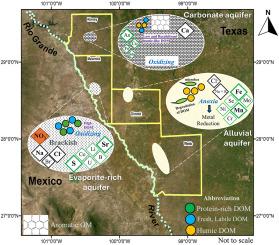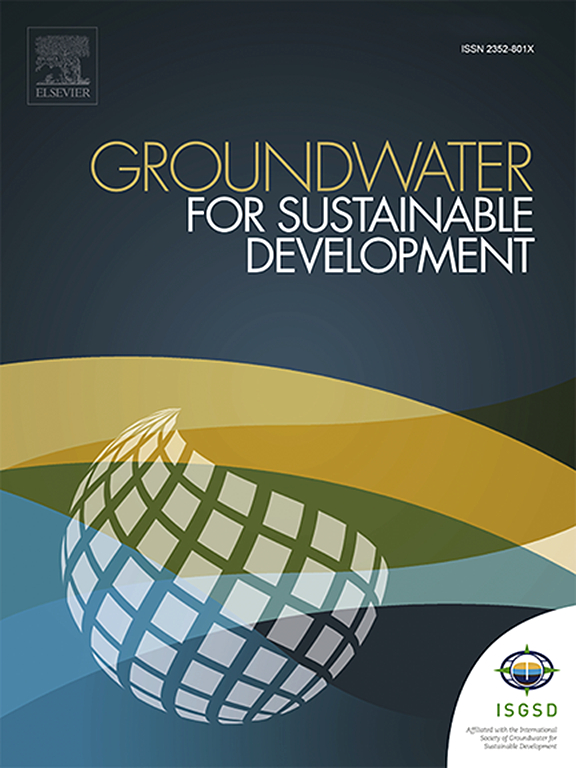Hydrogeochemical assessment of groundwater in transboundary aquifers along the US-Mexico border and drinking water quality implications for Texas colonias
IF 4.9
Q2 ENGINEERING, ENVIRONMENTAL
引用次数: 0
Abstract
The groundwater resources in transboundary aquifers are crucial to the development of involved nations. A unified governance strategy based on scientific data is essential for the management of transboundary aquifers. This study presents a comprehensive geochemical analysis of the groundwater quality of private wells along the US-Mexico border in Texas across three transboundary aquifer types. The concentrations of dissolved major ions, trace, and rare earth elements (REE) were measured, and the dissolved organic matter was spectroscopically characterized to evaluate the prevailing water-rock interactions, biogeochemical reactions, and anthropogenic contamination in the groundwater and their susceptibility to future contamination. Groundwater samples were collected from private wells (n = 22) from four representative counties within a section of the Texas-Mexico border (Maverick, Kinney, Dimmit, and Webb Counties). Three distinct aquifer types were revealed from the major ion composition, e.g., a carbonate aquifer within Kinney County (a part of Edwards-Trinity aquifer), an alluvial aquifer with prevailing reducing conditions within Dimmit and Webb Counties (a part of Carrizo-Wilcox aquifer), and an evaporite-rich aquifer within Maverick County. The concentrations of trace elements in the groundwater of each aquifer type were below the MCL of USEPA, however, excessive Sr concentrations were evident mostly in the evaporite-rich aquifer. Our results indicate dissolution of evaporites, and possible anthropogenic contamination may be responsible for the degradation of groundwater quality in Maverick County, raising concern for the viability of the aquifer in the future.

美墨边境跨界含水层地下水水文地质化学评估及对得克萨斯州殖民地饮用水质量的影响
跨界含水层中的地下水资源对有关国家的发展至关重要。基于科学数据的统一治理战略对于跨界含水层的管理至关重要。本研究对德克萨斯州美墨边境沿线私人水井的地下水水质进行了全面的地球化学分析,涉及三种跨界含水层类型。研究人员测量了溶解的主要离子、痕量元素和稀土元素 (REE) 的浓度,并对溶解的有机物进行了光谱鉴定,以评估地下水中普遍存在的水与岩石的相互作用、生物地球化学反应、人为污染及其对未来污染的易感性。地下水样本取自得克萨斯州与墨西哥交界处四个具有代表性的县(马弗里克县、金尼县、迪米特县和韦伯县)的私人水井(n = 22)。从主要离子组成中可以看出三种不同的含水层类型,例如,金尼县的碳酸盐含水层(爱德华兹-特里尼含水层的一部分)、迪米特县和韦伯县具有普遍还原条件的冲积含水层(卡里索-威尔科克斯含水层的一部分)以及马弗里克县富含蒸发岩的含水层。每种含水层类型的地下水中微量元素的浓度都低于美国环保局的 MCL 标准,但锶浓度超标的情况主要出现在富含蒸发岩的含水层中。我们的研究结果表明,蒸发岩的溶解和可能的人为污染可能是导致马弗里克县地下水水质恶化的原因,从而引发了人们对含水层未来生存能力的担忧。
本文章由计算机程序翻译,如有差异,请以英文原文为准。
求助全文
约1分钟内获得全文
求助全文
来源期刊

Groundwater for Sustainable Development
Social Sciences-Geography, Planning and Development
CiteScore
11.50
自引率
10.20%
发文量
152
期刊介绍:
Groundwater for Sustainable Development is directed to different stakeholders and professionals, including government and non-governmental organizations, international funding agencies, universities, public water institutions, public health and other public/private sector professionals, and other relevant institutions. It is aimed at professionals, academics and students in the fields of disciplines such as: groundwater and its connection to surface hydrology and environment, soil sciences, engineering, ecology, microbiology, atmospheric sciences, analytical chemistry, hydro-engineering, water technology, environmental ethics, economics, public health, policy, as well as social sciences, legal disciplines, or any other area connected with water issues. The objectives of this journal are to facilitate: • The improvement of effective and sustainable management of water resources across the globe. • The improvement of human access to groundwater resources in adequate quantity and good quality. • The meeting of the increasing demand for drinking and irrigation water needed for food security to contribute to a social and economically sound human development. • The creation of a global inter- and multidisciplinary platform and forum to improve our understanding of groundwater resources and to advocate their effective and sustainable management and protection against contamination. • Interdisciplinary information exchange and to stimulate scientific research in the fields of groundwater related sciences and social and health sciences required to achieve the United Nations Millennium Development Goals for sustainable development.
 求助内容:
求助内容: 应助结果提醒方式:
应助结果提醒方式:


